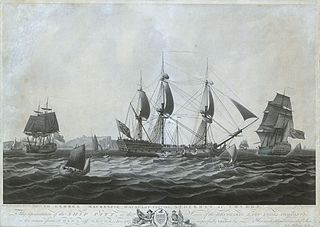Britannia may refer to any one of a large number of ships:
Many vessels have been named Minerva for the mythological figure Minerva:

Fortitude was a merchant vessel built in 1780 on the River Thames. A French frigate captured her in 1782 while she was on the return leg of her maiden voyage to India as an East Indiaman for the British East India Company (EIC). However, the British recaptured her in October 1782. The EIC purchased her and sent her back to England. There, in 1785, George Macartney Macauley purchased her and renamed her Pitt. She then performed five voyages for the British East India Company (EIC) between 1786 and 1798. In between, she made one journey transporting convicts from England to New South Wales. She was broken up in 1801.
Royal Admiral was an East Indiaman, launched in 1777 on the River Thames. She made eight trips for the East India Company (EIC) before she was sold. She then continued to trade. She made two trips carrying convicts from England to Australia, one as an East Indiaman in 1791, and a second in 1800. On this second voyage as a convict transport she was present at a notable naval action.
Several vessels have been named Thames, for the River Thames:
A number of ships have been named Asia, including:
Numerous ships have sailed under the name Antelope. Notable ones include:

Swallow was a teak-built packet ship that the British East India Company (EIC) launched at Bombay in 1779. She made nine trips between India and Britain for the EIC between 1782 and 1803. Her most notable exploit occurred on her seventh voyage, when she helped capture seven Dutch East Indiamen on 15 June 1795. The Royal Navy purchased her in 1804 and named her Lilly. She served in the navy until she was sold in 1811. During this time she participated in the capture of La Désirade island, and participated in a quixotic and unsuccessful attempt of General Francisco de Miranda to liberate the Province of Venezuela from Spain in 1806. Her whereabouts between 1811 and 1815 are obscure, but in 1815 J. Lyney, of London, purchased her and she sailed to the West Indies and to India as an EIC-licensed vessel until she wrecked on her way to Calcutta in 1823.
Several vessels have been named Harriet, or Harriot:
Numerous ships have been named Juliana:
Royal Edward was launched in 1782 in France as Alexandre. The British captured her c.1796, and new owners changed her name. She then sailed for a few years as a West Indiaman before completing four voyages as a slave ship. She returned to the West India trade after leaving the slave trade, and then traded more generally. She was condemned as unseaworthy and broken up in Bengal in 1815.
Numerous vessels have borne the name Active :

Java was a merchant ship launched at Calcutta, British East India, in 1811. She made one voyage under charter to the British East India Company (EIC). She served in the migrant trade between Great Britain and Australia and in Far East trade. She became a coal hulk at Gibraltar circa 1859. She survived until World War II.
Several ships have been named Reliance:
Several ships have been named Swallow for the bird Swallow:
Several vessels have been named Brilliant:
Several vessels have been named Westmoreland:
Fortitude was launched at Calcutta in 1804. In 1806 she carried Chinese labourers to Trinidad for the British East India Company; she was seized in Trinidad, sold, and sailed to England. From 1808 on she was a West Indiaman. She was lost circa 1812.
This page is based on this
Wikipedia article Text is available under the
CC BY-SA 4.0 license; additional terms may apply.
Images, videos and audio are available under their respective licenses.


